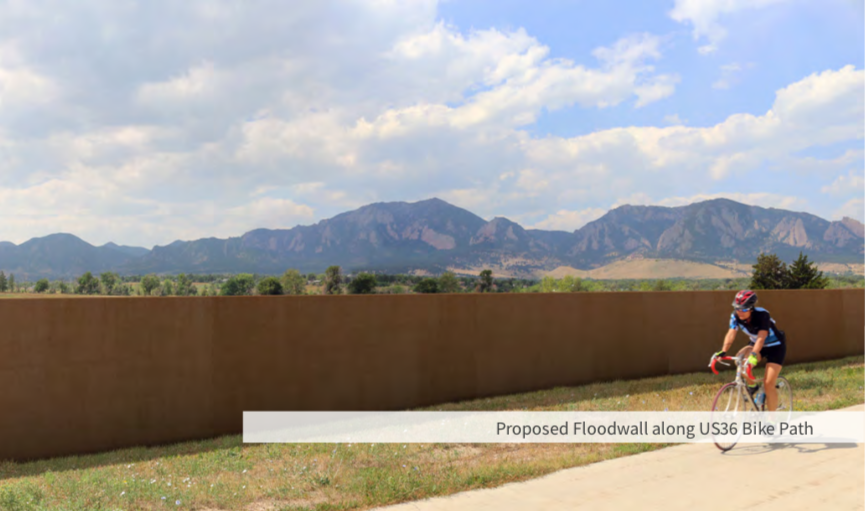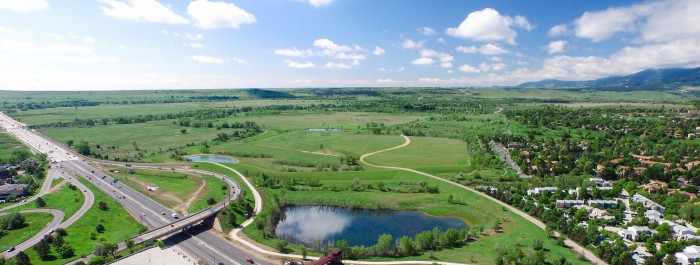
Wednesday, Nov. 19, 2020
Boulder and the University of Colorado are drawing closer on broad agreements for adding 308 acres to the city that will allow the university to access utilities and eventually build out a southern campus. In exchange, Boulder will get free land to build a flood wall, dam and detention along South Boulder Creek, saving thousands of homes downstream.
It remains to be seen if the years of work will be enough to soothe the anxieties of growth-adverse neighborhood groups who have continued to express opposition — including through paid Daily Camera advertisements
that proponents of flood control say are spreading misinformation.
City council received an update Tuesday on the annexation process. Staff have taken the CU South guiding principles — a document developed in 2017 — and created a Briefing Brief to walk elected officials and members of the public through the terms of annexation and plans for the eventual parcel.
Read a live-tweet thread of Tuesday’s discussion
A public engagement period will begin in December; council will give feedback in January or February, with a final vote scheduled for June. Actual construction of flood mitigation on the land is still years away — if there are no further delays, the project won’t wrap until 2026.
Development of CU South by the university will take even longer, which is the crux of the conflict for many. Annexations are typically accompanied by details designs of what will be built there. But CU won’t know for years what its southern campus will look like, and state entities are not beholden to Boulder’s regulations. That has made elected officials wary of approving vague plans — even though the city desperately needs the 80 acres CU intends to donate for flood protection.
Negotiations have been ongoing for more than a year. Here’s a high-level look at where things stand.
What still needs to be worked out?
Where athletic fields will go. CU has maintained it needs 30 acres for athletic fields, but a portion of the land zoned for development may be unavailable due to the city’s flood mitigation. So the university wants to some land zoned as Open Space – Other for the fields. That’s a no-go for Boulder.
From the Briefing Book: “City staff proposed that, should the Park, Urban and Other area not be suitable for recreation fields, an earnest evaluation of additional potential sites on the Public area, elsewhere on the CU Boulder campus, or off-site locations within the proximity of CU South be pursued.”
Payment in lieu of taxes. When land is added to the city which doesn’t contribute property tax — CU, as a state entity, is exempt — a PILOT plan is usually developed. The university is opposed to a PILOT. They have offered two additional acres of donated land for the relocation of a Boulder fire station.
Councilman Mark Wallach pushed back on that offer in an email to city staff. “The tax-exempt status of CU is not a justification not to pay some form of PILOT to compensate Boulder for the expense of City services that will be provided to CU over the next 50 years, it is the very reason that those payments should be made via a PILOT program.”
He asked for a financial analysis of a PILOT versus the value of the two lands the university is offering. That is being evaluated now, staff said.
What’s been agreed upon?
Many things, including a limit on how high CU will build (55 feet, the city’s official building height limit) and a “target” of 1,100 housing units on the site. The university has agreed to make living spaces a “predominant” use of the campus, minimizing non-residential uses and providing dwellings for university faculty, staff and non-freshmen students.
Boulder will get an opportunity to weigh eventual development through three avenues:
- Campus Master Plan (under state law, updated every 10 years; includes a meeting with city council)
- CU South Master Plan (allows for 90-day review and comments. According to the Briefing Book, “CU Boulder will give strong consideration to the City’s Discretionary Comments and may recommend plan amendments to CU’s Design Review Board.”)
- Conceptual development plans for CU South (same as above, except review period is 60 days)
City staff characterize this as a partial agreement because Boulder wants 90 days to review design concepts.
Other areas of agreement include:
- Preserving, protecting and/or restoring 44 acres of wetland and open space
- Building heights will “transition gently” as they approach adjacent neighborhoods
- Using 36 acres for flood mitigation (construction of a dam, flood wall and detention)
Ways to engage
A Be Heard Boulder (online) questionnaire will launch in December. The city will host a number of neighborhood meetings and small group discussions as well.
Small group discussion schedule
More details TBD
- Dec. 1, 2-3 p.m.
- Dec. 2, 10–11 a.m.
- Dec. 7, 2–3 p.m.
- Dec. 8, 2–3 p.m.
- Dec. 15, 2–3 p.m.
A secondary engagement effort will take place after transportation studies are complete in January. A “trip budget” is being considered to cap the maximum number of trips in and out of the site at various access points. That may guide future development in order to stay within budget.
Feedback will be focused on two questions for existing annexation agreements. For items where the city and CU are mostly aligned, residents will be asked, “Is this going in the right direction?” For issues yet to be resolved, they will be asked, “Under what conditions would you accept _____”
The idea is to guide input based on shared goals of flood protection and eventual development, Mayor Sam Weaver said Tuesday. Some residents have continued to ask that the land be left as-is, or that the university should donate acreage to Boulder for flood mitigation but build a campus elsewhere.
“There’s an extremely small possibility that nothing will happen on this property” but the much more likely possibility is that flood protection will happen, Weaver said. “We do want to put the reality out there that there’s a high likelihood something will happen.”
Myth-busting? Maybe
Resident expectations received a bit of attention Tuesday. Several members of the public, during open commentDedicated time at the beginning of regular council meetings, where up to 20 members of the public ca..., asked that a “myth busting” or “Frequently Asked Questions” section be added to the Briefing Book to counter widespread misinformation about the CU South project.
Some council members echoed those requests. Mayor Weaver was supportive but urged caution; council members in the past have been careful not to criticize resident campaigns, for fear of squashing public discourse.
If the city is going to engage in myth-busting, it needs to stick to facts, Weaver said Tuesday. “Some things that people think are misinformation are really just differences of opinion.”
This summer, Save South Boulder and PLAN-Boulder County — two groups opposed to development at CU South — ran half-page, full-color ads in the Daily Camera depicting a 30-foot-high concrete flood wall running along U.S. 36, obscuring views of the Flatirons. A spokesperson admitted the images were meant to draw attention — not to reflect reality of what will eventually be built.
Staff were distressed by the images, telling Boulder Beat that such misinformation complicates city engagement efforts. Similar ads appeared in the Camera on Oct. 11. The claims, while not outright inaccurate, lack context and leave out important updates to past information.
Margaret LeCompte, an organizer with Save South Boulder, on Tuesday questioned staff’s assertions that CU and the city are close to total agreement. There remain “unresolvable conflicts,” she said, and Boulder should slow down the process.
“I want to question the haste with which the annexation is being rammed through,” LeCompte said. “Much more time is needed for authentic public engagement.”
A half-dozen others — including organizers of South Boulder Creek Action Group, a proponent of flood control — praised the city for its efforts. Nicole Speer, a resident of nearby Tantra Park, said she was “thrilled” about the possibility of a running track and dog park, two amenities CU has offered as potential public facilities.
“These possibilities for my neighborhood are exciting,” she said. “We can use this annexation process to envision an annexation process that benefits all of us.”
— Shay Castle,
boulderbeatnews@gmail.com, @shayshinecastle
Want more stories like this, delivered straight to your inbox? Click here to sign up for a weekly newsletter from Boulder Beat.
CU South Boulder city council city of Boulder CU CU South Daily Camera dam detention flood mitigation flood wall PLAN Boulder County Sam Weaver Save South Boulder South Boulder Creek Action Group University of Colorado

